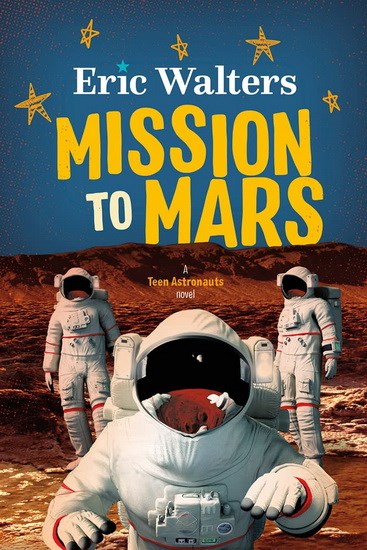Mission to Mars

Mission to Mars
“I need numbers, and I need them fast!” I snapped.
“Altitude is ninety-three feet, rate of descent seven feet per second, distance is seventy-three feet, and speed is eleven feet per second. We’re almost there!” Ashley called out.
I eased up again on the thrusters. We’d be directly over the landing spot in eight seconds and on the ground in seven. That was almost exactly perfect.
“Hang on…hang on,” I said.
I held the thruster positions and counted down from seven in my head, and then there was a clunk and the whole ship seemed to shudder and stop.
“Kill the engines! Kill the engines!”
Everything shut down. There was no sense of motion. No shaking. No vibrations. No sound. We’d touched down.
“Welcome to Mars.”
Fourteen-year-olds Houston, Ashley, and Teal, recruited as young test subjects for an interplanetary mission, find themselves alone on their way to Mars after the death of the adult crew in an onboard fire. Cramming in extra training and in constant communication with Mission Control on Earth, they are able to successfully pilot the ship to become the first humans to land on Mars. There, they encounter medical, weather, and survival emergencies while navigating their own relationships and mourning their adult mentors. After over a year, as their departure window approaches, Mission Control abruptly aborts their return, citing structural stress on the ship. Unwilling to wait for a rescue ship, the teens defy orders and return successfully to Earth.
In this third installment of the “Teen Astronauts” series, Eric Walters continues the story of three teens as they face challenges in space beyond what they were prepared for. The pace is fast and exciting, the challenges daunting and realistic, and the science behind the story mostly believable and evidently well-researched. Set in what seems to be the near future, the mission involves the (contemporary) International Space Station and international cooperation involving American, Canada, South Korean, and Russian astronauts, with Chinese participation in the future hinted at. The teens face their own doubts and both mental and physical limitations, balanced out by their extensive training and the expertise of the three: Houston in astrophysics, Ashley in engineering and Teal in medicine. No teen novel being complete without tension with adults, the teens encounter resistance and even subterfuge from the adults at Mission Control, but constantly reiterate their respect and even reverence for their elders. Even gender relations are given a nod when Houston (male, and the interim commander) insists that Ashley and Teal (female, second in command) become the first to set foot on Mars.
Character development is occasionally stilted, with differences between Ashley and Teal often indiscernible, other than as related to their expertise and family situations (all are orphaned in one way or another). Told from the point of view of Houston, there is ample effort made to ensure both genders are equally respected, but the romantic encounters Houston has with both girls is a bit forced (although when on the operating table for an emergency appendectomy from Teal, it is hilarious when he deliriously announces he wants to marry them both). The science and technology is mostly convincing, although the fact that advance supply ships were able to earlier land on Mars via remote control, given the several-minute-long communication delay from Earth, seems a bit of a stretch. Nonetheless, the constant reiteration of the need for redundancy, and the fact that any anomaly might result in the deaths of the three, provides both scientific bona fides and dramatic tension.
Todd Kyle is the CEO of the Brampton Library.
